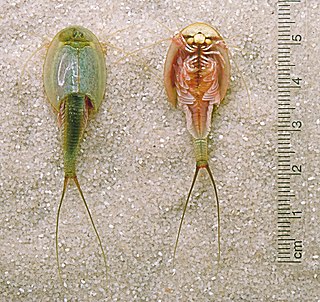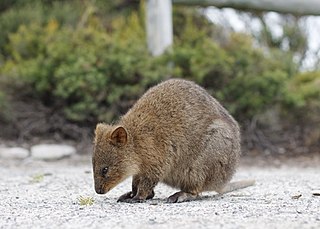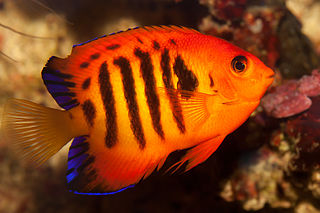
Branchiopoda is a class of crustaceans. It comprises fairy shrimp, clam shrimp, Cladocera, Notostraca and the Devonian Lepidocaris. They are mostly small, freshwater animals that feed on plankton and detritus.

Shellfish is a colloquial and fisheries term for exoskeleton-bearing aquatic invertebrates used as food, including various species of molluscs, crustaceans, and echinoderms. Although most kinds of shellfish are harvested from saltwater environments, some are found in freshwater. In addition, a few species of land crabs are eaten, for example Cardisoma guanhumi in the Caribbean. Shellfish are among the most common food allergens.

The quokka, also known as the short-tailed scrub wallaby, the only member of the genus Setonix, is a small macropod about the size of a domestic cat. Like other marsupials in the macropod family, the quokka is herbivorous and mainly nocturnal.

Clam shrimp are a taxon of bivalved branchiopod crustaceans that resemble the unrelated bivalved molluscs. They are extant, and known from the fossil record, from at least the Devonian period and perhaps before. They were originally classified in a single order Conchostraca, which later proved to be paraphyletic, being separated into three different orders: Cyclestherida, Laevicaudata, and Spinicaudata.
Reef safe is a distinction used in the saltwater aquarium hobby to indicate that a fish or invertebrate is safe to add to a reef aquarium. There is no fish that is completely reef safe. Every fish that is commonly listed as reef safe are species that usually do not readily consume small fish or invertebrates. Fish listed as reef safe also do not bother fellow fish unless in some cases, for instance tangs, they do not get along with conspecifics and sometimes fish with similar color or body shape. Every fish has a personality, is different, and, in some cases, are opportunistic feeders. Tangs, which by most accounts are reef safe, may in adulthood eat some crustaceans shortly after they molt. Many larger predatory fish, for instance eels and pufferfish, will adapt very well to a reef tank and will be problem-free as long as they have sizable tank-mates and no crustaceans. Some aquarists have also had success in keeping smaller fish with predatory ones in reef tanks by adding the smaller fish at night, sometimes with newly rearranged rockwork.

The flame angelfish is a marine angelfish of the family Pomacanthidae found in tropical waters of the Pacific Ocean. Other common names include flame angel, flaming angelfish and Japanese pygmy angelfish.
Eoleptestheria ticinensis is a species of clam shrimp in the family Leptestheriidae. Although up to eight species have formerly been recognised in the genus Eoleptestheria, they are more usually all considered part of one species with a cosmopolitan distribution.

Bandon Marsh National Wildlife Refuge is a U.S. National Wildlife Refuge on Oregon's coast. It is one of six National Wildlife Refuges comprising the Oregon Coast National Wildlife Refuge Complex and is renowned among bird watchers for being able to view rare shorebirds including ruff, Hudsonian godwit, and Mongolian plover. The refuge was last expanded in 1999, it now has 889 acres (3.60 km2) in two units: Bandon Marsh and Ni-les'tun.
The graceful clam shrimp is a species of clam shrimp found in Texas, northern Florida and possibly other regions in between.

The ocean quahog is a species of edible clam, a marine bivalve mollusk in the family Arcticidae. This species is native to the North Atlantic Ocean, and it is harvested commercially as a food source. This species is also known by a number of different common names, including Icelandic cyprine, mahogany clam, mahogany quahog, black quahog, and black clam.

Jay Westerveld is an American environmentalist and researcher of habitats associated with endangered species including the Clam shrimp, Bog turtle, and the Northern Cricket frog. Westerveld coined the term "greenwashing" and has mounted ecological preservation efforts in the state of New York.

Meinmahla Kyun Wildlife Sanctuary is a protected area in Myanmar with an extent of 500 km2 (190 sq mi) and one of the ASEAN Heritage Parks. Meinmahla Kyun is an island in the Ayeyarwady Delta ranging in elevation from 0 to 30 m and covered by mangrove forest. It was declared a Ramsar site in 2017.
Aquaculture in Alaska is dominated by the production of shellfish and aquatic plants. These include Pacific oysters, blue mussels, littleneck clams, scallops, and bull kelp. Finfish farming has been prohibited in Alaska by the 16.40.210 Alaskan statute, however non-profit mariculture continues to provide a steady supply of aquaculture in the state. Many organizations that helped the ban, now encourage the growing of shellfish and other oysters.

Shrimp are decapod crustaceans with elongated bodies and a primarily swimming mode of locomotion – most commonly Caridea and Dendrobranchiata. More narrow definitions may be restricted to Caridea, to smaller species of either group or to only the marine species. Under a broader definition, shrimp may be synonymous with prawn, covering stalk-eyed swimming crustaceans with long narrow muscular tails (abdomens), long whiskers (antennae), and slender legs. Any small crustacean which resembles a shrimp tends to be called one. They swim forward by paddling with swimmerets on the underside of their abdomens, although their escape response is typically repeated flicks with the tail driving them backwards very quickly. Crabs and lobsters have strong walking legs, whereas shrimp have thin, fragile legs which they use primarily for perching.

Cyzicus is a genus of clam shrimps in the family Cyzicidae. Identified by Jean Victoire Audouin in 1837, the genus was reidentified as Caenestheriella by Eugen von Daday in 1910.

Acanthopagrus berda, the goldsilk seabream, sly bream or picnic seabream, among other names, is a marine fish in the family Sparidae native to the Indian Ocean. Feeding activity intensifies in the summer and is related to temperature and the maximal abundance of benthic organisms. Their diet primarily consists of barnacles, crabs, and oysters, while the secondary food items consist of shrimp, clam and mussels, although the species' diet consists of a wide variety ranging from feeding on teleost, worms, molluscs, small fishes, and plant material.
Lynceus is a genus of clam shrimp in the family Lynceidae. There are about 13 described species in Lynceus.
Lynceidae is a family of clam shrimp in the order Laevicaudata. There are about 5 genera and more than 20 described species in Lynceidae.










